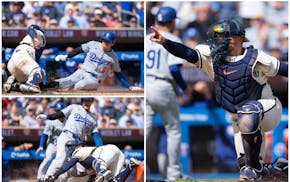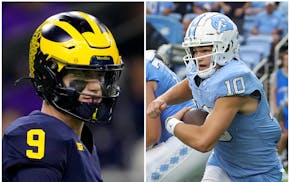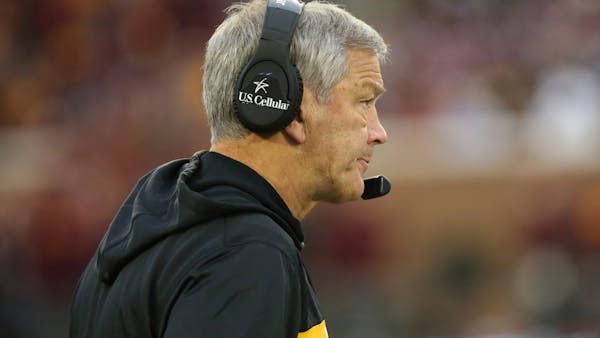The 83rd edition of the battle for Floyd of Rosedale can be described a number of ways.
Entertaining, sure.
High-scoring, yep.
Mistake-filled, indeed.
History, however, won't remember it as brainiac football. The Gophers and Iowa combined for some confounding decisions that changed the complexion of the game and left you scratching your head in disbelief.
The border rivals gift-wrapped points to each other during a weird sequence of events in the first half of what turned into a 48-31 Iowa win on Homecoming Saturday at TCF Bank Stadium.
The game included a dizzying display of momentum swings, highlighted by risky decisions — at least two unnecessarily risky — late in the first half.
Gophers coach P.J. Fleck had two decisions put under a microscope. The first came after a stand by his defense inside the Gophers' own 10-yard line.
Leading 14-7, the Hawkeyes had the ball first-and-goal from the 6. The Gophers held them to 2 yards, setting up a fourth down.
The Hawkeyes sent out their kicker, holder and long snapper, but the formation indicated trick play.
Seven players shifted to the right, leaving long snapper Jackson Subbert by himself in the middle of the line. Fleck didn't call a timeout in a situation that screamed for one.
Subbert tossed the snap right to T.J. Hockenson, the nearest player to him on the outside. Hockensen followed his blocking 4 yards for a touchdown on the old swinging gate play.
Fleck said he didn't call a timeout because his team works on "muddle" alignments on field goals every week.
"If our guys [had looked confused] I would have immediately called a timeout," Fleck said. "But there was no panic in our team. They knew exactly where to go. They knew exactly what to do. Just didn't execute it."
Fleck tried his own trickery late in the second quarter and it backfired.
The Gophers trailed 21-10 with a little more than two minutes left until halftime. They faced a fourth-and-5 from their own 49.
The safe play would be to punt, pin the Hawkeyes deep and go into halftime in reasonable shape.
Fleck gambled.
He called a fake punt and asked punter Jacob Herbers to throw a deep pass down the sideline to Chris Autman-Bell, which fell incomplete.
"I loved the decision," Fleck said.
I didn't. Why give Iowa a short field with an 11-point lead and enough time to score, knowing the Hawkeyes were getting the ball to open the second half? Especially since the Gophers defense looked incapable of producing a meaningful stop.
There's a difference between being aggressive and reckless, and Fleck's decision fell on the wrong side on that one.
Predictably, Iowa drove 49 yards for a touchdown and 28-10 lead.
"Worrying about the short field is why you fake it there," Fleck said. "They don't think you're going to fake it. We just threw the ball out of bounds. We hadn't thrown the ball out of bounds in the last two weeks of practice on it."
The damage done turned out to be "a wash" — in Fleck's words — because of a brain cramp by Iowa quarterback Nate Stanley right before halftime.
The Hawkeyes took possession at their own 20 with 1:12 left after an interception in the end zone. On first down, Stanley rolled right, couldn't find any open receivers and his only option should have been to throw the ball out of bounds. Instead, he inexplicably fired into traffic right to Gophers safety Jacob Huff, who returned the interception to the 6.
A touchdown catch by Tyler Johnson followed that gift, making the halftime deficit 11 points rather than 18.
Those decisions didn't decide the game's outcome. The better team won, largely because the Gophers pass defense looked hopeless.
But those risks were miscalculations in the context of time and score.
"Some decisions that I make is because we're down," Fleck said. "You've got to make those calls and sometimes you need to give them a boost. If we hit the play, we're all saying it's a great play. We don't hit it and [people say], 'Why did you do that?' "
Chip Scoggins chip.scoggins@startribune.
Scoggins: Why 'championship or bust' fits these Wolves

Scoggins: Anatomy of a game-saving play as Correa throws out Ohtani

Scoggins: McCarthy or Maye? Ex-U coach breaks down Vikings' options
Scoggins: Cory Provus getting ready for 'biggest challenge' of career


